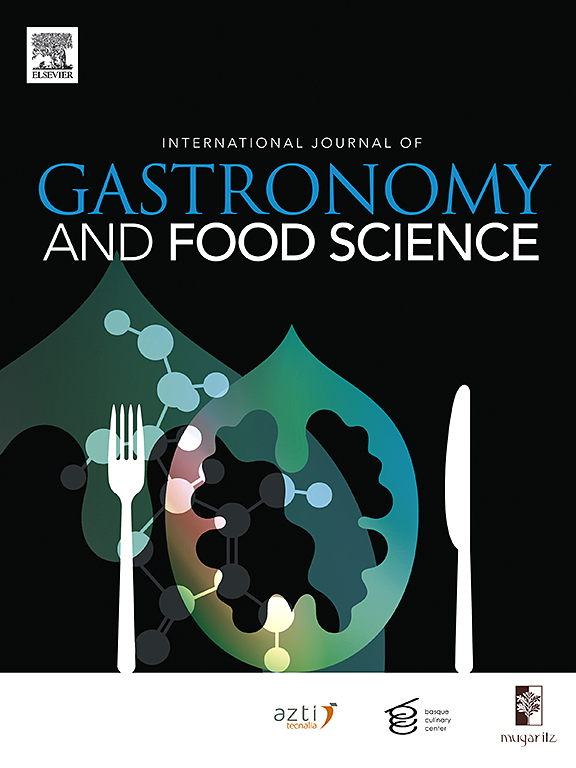基于HPLC、LC-ESI-MS/MS和电子舌的无定鸡加工过程中风味物质变化综合分析
IF 3.2
2区 农林科学
Q2 FOOD SCIENCE & TECHNOLOGY
International Journal of Gastronomy and Food Science
Pub Date : 2025-05-14
DOI:10.1016/j.ijgfs.2025.101204
引用次数: 0
摘要
无定鸡肉质鲜美,风味独特,深受消费者喜爱。本研究采用高效液相色谱(HPLC)、高效液相色谱串联质谱电喷雾电离(LC-ESI-MS/MS)和电子舌对无定鸡在不同加工阶段(生肉、炖煮1 h、油炸1 min、炖煮2 h)的风味物质进行了分析。结果表明,武定鸡炖2 h后主要呈味核苷酸(味觉活性值,TAV>1)为5′-IMP和5′-GMP。无定鸡4个加工阶段共检出19种游离氨基酸,其中谷氨酸含量最高。加工后的无定鸡的核心味道为咸味和鲜味,炖2 h的鸡肉鲜味较强,EUC值为6.41 g·100 g−1。这些结果直接证明了武定鸡的味道本质,为进一步深入研究地方鸡的风味特征提供了科学的理论依据。本文章由计算机程序翻译,如有差异,请以英文原文为准。
Comprehensive analysis of changes in taste substances during the processing of Wuding chicken based on HPLC, LC-ESI-MS/MS, and electronic tongue
Wuding chicken is highly favored by consumers due to its delicious meat and unique flavor. In this study, the taste substances of Wuding chicken at different processing stages (raw meat, stewed for 1 h, deep-fried for 1 min, and stewed for 2 h) were analyzed by high-performance liquid chromatography (HPLC), high-performance liquid chromatography tandem mass spectrometry electrospray ionization (LC-ESI-MS/MS) and electronic tongue. The results showed that the main flavor-presenting nucleotides (Taste Activity Value, TAV>1) in Wuding chicken stewed for 2 h were 5′-IMP and 5′-GMP. Nineteen free amino acids were detected in all four processing stages of Wuding chicken, among which glutamic acid had the highest content. The core tastes of processed Wuding chicken were salty and umami, and the chicken stewed for 2 h had a strong umami, with an EUC value of 6.41 g·100 g−1. These results are direct evidence of the essence of the taste of Wuding chicken and provide scientific theoretical basis for further in-depth research on the flavor characteristics of local chicken.
求助全文
通过发布文献求助,成功后即可免费获取论文全文。
去求助
来源期刊

International Journal of Gastronomy and Food Science
Social Sciences-Cultural Studies
CiteScore
5.30
自引率
10.50%
发文量
170
审稿时长
45 days
期刊介绍:
International Journal of Gastronomy and Food Science is a peer-reviewed journal that explicitly focuses on the interface of food science and gastronomy. Articles focusing only on food science will not be considered. This journal equally encourages both scientists and chefs to publish original scientific papers, review articles and original culinary works. We seek articles with clear evidence of this interaction. From a scientific perspective, this publication aims to become the home for research from the whole community of food science and gastronomy.
IJGFS explores all aspects related to the growing field of the interaction of gastronomy and food science, in areas such as food chemistry, food technology and culinary techniques, food microbiology, genetics, sensory science, neuroscience, psychology, culinary concepts, culinary trends, and gastronomic experience (all the elements that contribute to the appreciation and enjoyment of the meal. Also relevant is research on science-based educational programs in gastronomy, anthropology, gastronomic history and food sociology. All these areas of knowledge are crucial to gastronomy, as they contribute to a better understanding of this broad term and its practical implications for science and society.
 求助内容:
求助内容: 应助结果提醒方式:
应助结果提醒方式:


